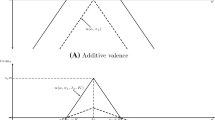Abstract
Several recent spatial modeling studies incorporate valence issues—e.g., voters’ evaluations of the candidates’ competence, integrity, and charisma—that may give one of the candidates an electoral advantage that is independent of his policy positions. However to date all such models assume that while voters value positive valence characteristics, the candidates themselves do not. We develop a spatial model where the candidates are valence-seeking, i.e.—like the voters—the candidates prefer that the winning candidate possess qualities, such as integrity, diligence, and competence, that will enhance his job performance. We analyze a spatial model where the candidates value both the valence qualities and the policies of the winning candidate, and we show that the candidates’ optimal policy choices typically diverge as the valence differential between them increases, and in particular that the valence-disadvantaged candidate normally has incentives to become more extreme as the valence advantage of her opponent increases.
Similar content being viewed by others
References
Abney, R., Adams, J., Clark, M., Easton, M., Ezrow, L., Kosmidis, S., & Neundorf, A. (2011). When does valence matter? Heightened valence effects for governing parties during election campaigns. Party Politics. First published on June 29, 2011 as doi: 10.1177/1354068810395057.
Adams, J. (1999). Policy divergence in multicandidate probabilistic spatial voting. Public Choice, 99, 259–274.
Adams, J., & Merrill, S. III (2006). Why small, centrist third parties motivate policy divergence by major parties. American Political Science Review, 100(3), 403–417.
Adams, J., & Merrill, S. III (2009). Policy-seeking parties in a parliamentary democracy with proportional representation: a valence-uncertainty model. British Journal of Political Science, 39(3), 539–558.
Adams, J., Merrill, S. III, & Grofman, B. (2005). A unified theory of party competition: a cross-national analysis integrating spatial and behavioral factors. Cambridge: Cambridge University Press.
Adams, J., Merrill, S. III, Simas, E., & Stone, W. (2011). When candidates value good government: a spatial model with applications to congressional elections. Journal of Politics, 73(1), 17–30.
Ansolabehere, S., & Snyder, J. (2000). Valence politics and equilibrium in spatial voting models. Public Choice, 103, 327–336.
Aragones, E., & Palfrey, T. (2002). Mixed equilibrium in a Downsian model with a favored candidate. Journal of Economic Theory, 103(1), 131–161.
Brams, S., & Merrill, S. III (1983). Equilibrium strategies for final-offer arbitration: there is no median convergence. Management Science, 29(August), 927–941.
Brams, S., & Merrill, S. III (1991). Final-offer arbitration with a bonus. European Journal of Political Economy, 7(August), 79–92.
Bruter, M., Erikson, R., & Strauss, A. (2010). Uncertain candidates, voters with valence, and the dynamics of candidate position-taking. Public Choice, 44(1–2), 153–168.
Calvert, R. (1985). Robustness of the multidimensional voting model: candidates, motivations, uncertainty, and convergence. American Journal of Political Science, 29(1), 69–95.
Clark, M. (2009). Valence and electoral outcomes in Western Europe, 1976–1998. Electoral Studies, 28(1), 111–122.
Crewe, I., & King, A. (1994). Are British elections becoming more ‘presidential’? In M. K. Jennings & T. E. Mann (Eds.), Elections at home and abroad. Ann Arbor: University of Michigan Press.
Feller, W. (1968). Introduction to probability theory and its applications (Vol. 1). New York: Wiley.
Fiorina, M. (1977). Representatives, roll-calls, and constituencies. Lexington: Lexington Books.
Grose, C. R. (2005). Do legislators use “pork” projects to deviate from constituents’ interests? Valence advantages and position-taking in Congress. Typescript.
Grose, C. R., Bystrom, A., & Hate, A. (2004). Valence advantages and legislative position-taking in 1996 campaigns for the U.S. House. Typescript.
Groseclose, T. (2001). A model of candidate location when one candidate has a valence advantage. American Journal of Political Science, 45(October), 862–886.
Hummel, P. (2010). On the nature of equilibria in a Downsian model with candidate valence. Games and Economic Behavior, 70(2), 425–445.
Johnston, R. (2000). Prime ministerial contenders in Canada. In A. King (Ed.), Leaders’ personalities and the outcomes of democratic elections. Oxford: Oxford University Press.
Kazee, T. (1994). Who runs for congress? Ambition, context, and candidate emergence. Washington: CQ Press.
Londregan, J., & Romer, T. (1993). Polarization, incumbency, and the personal vote. In W. A. Barnett, M. Hinich, & N. Schofield (Eds.), Political economy: institutions, competition, and representation. New York: Cambridge University Press.
Mondak, J. (1995). Competence, integrity, and the electoral success of congressional incumbents. Journal of Politics, 57(December), 1043–1069.
Pierce, R. (2000). Candidate evaluations and presidential electoral choices in France. In A. King (Ed.), Leaders’ personalities and the outcomes of democratic elections. Oxford: Oxford University Press.
Roemer, J. (2001). Political competition: theory and applications. Cambridge: Harvard University Press.
Schofield, N., & Sened, I. (2005a). Multiparty competition in Israel, 1988–1996. British Journal of Political Science, 35(4), 635–663.
Schofield, N., & Sened, I. (2005b). Modeling the interaction of parties, activists and voters: why is the political center so empty? European Journal of Political Research, 44(3), 355–390.
Schofield, N., & Sened, I. (2006). Multiparty democracy: elections and legislative politics. Cambridge: Cambridge University Press.
Serra, G. (2010). Polarization of what? A model of elections with endogenous valence. Journal of Politics, 72(2), 426–437.
Serra, G. (2011). Why primaries? The party’s tradeoff between policy and valence. Journal of Theoretical Politics, 23(1), 21–51.
Somer-Topcu, Z. (2007). Party policy strategies and valence issues: an empirical study of eastern European party systems (Working paper).
Stokes, D. (1963). Spatial models of party competition. American Political Science Review, 57, 368–377.
Stokes, D. (1992). Valence politics. In D. Kavanaugh (Ed.), Electoral politics. Oxford: Clarendon Press.
Stone, W., Maisel, L. S., & Maestas, C. D. (2004). Quality counts: extending the strategic politician model of incumbent deterrence. American Journal of Political Science, 48(3), 479–495.
Wittman, D. (1973). Parties as utility maximizers. American Political Science Review, 67, 490–498.
Wittman, D. (1983). Candidate motivation: a synthesis of alternatives. American Political Science Review, 77, 142–157.
Wittman, D. (1990). Spatial strategies when candidates have policy preferences. In J. Enelow & M. Hinich (Eds.), Advances in the spatial theory of voting. Cambridge: Cambridge University Press.
Author information
Authors and Affiliations
Corresponding author
Rights and permissions
About this article
Cite this article
Adams, J., Merrill, S. Policy-seeking candidates who value the valence attributes of the winner. Public Choice 155, 139–161 (2013). https://doi.org/10.1007/s11127-011-9845-4
Received:
Accepted:
Published:
Issue Date:
DOI: https://doi.org/10.1007/s11127-011-9845-4




